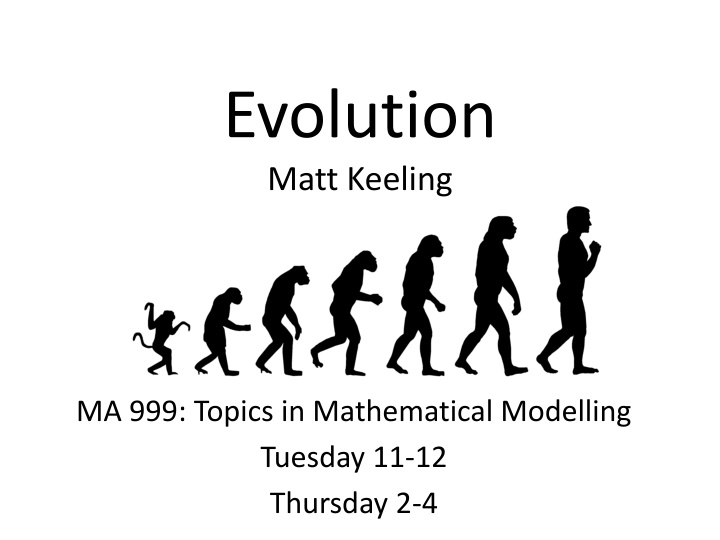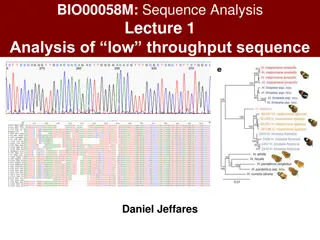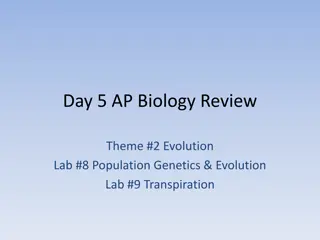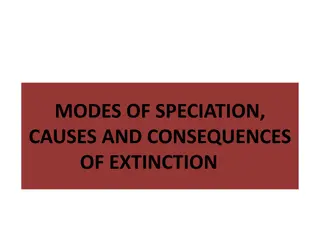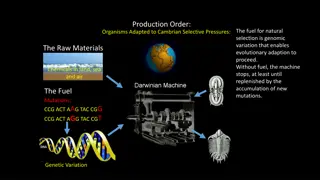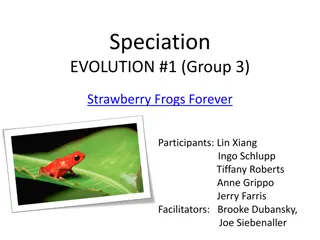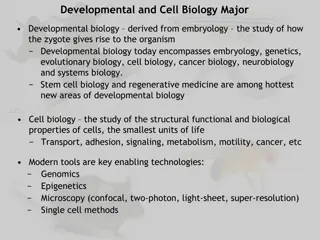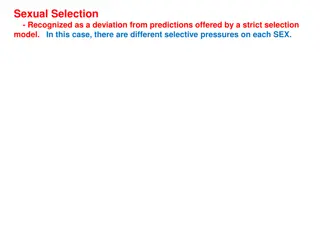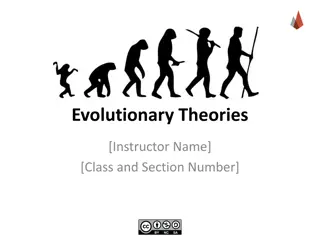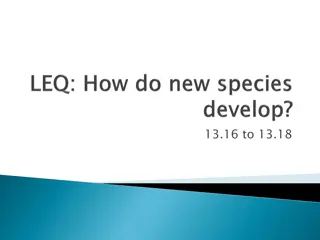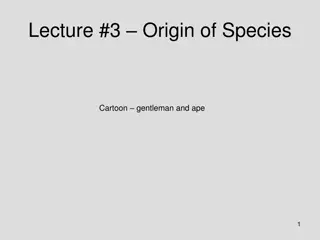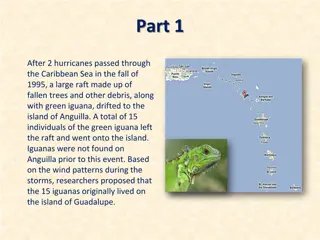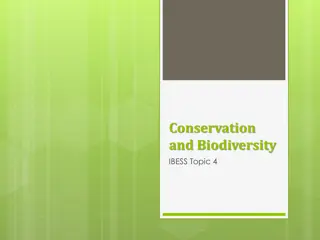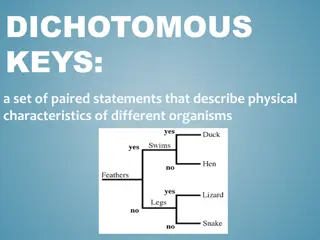Insights into Sexual Selection and Speciation in Evolutionary Biology
Explore the fascinating concepts of sexual selection, sex differences, and speciation in evolutionary biology through topics such as ornamentation in males, survival advantages, and the influence of mate preferences on offspring fitness. Dive into the mechanisms that drive the evolution of species and understand the role of sexual reproduction in shaping biodiversity.
Download Presentation

Please find below an Image/Link to download the presentation.
The content on the website is provided AS IS for your information and personal use only. It may not be sold, licensed, or shared on other websites without obtaining consent from the author.If you encounter any issues during the download, it is possible that the publisher has removed the file from their server.
You are allowed to download the files provided on this website for personal or commercial use, subject to the condition that they are used lawfully. All files are the property of their respective owners.
The content on the website is provided AS IS for your information and personal use only. It may not be sold, licensed, or shared on other websites without obtaining consent from the author.
E N D
Presentation Transcript
Evolution Matt Keeling MA 999: Topics in Mathematical Modelling Tuesday 11-12 Thursday 2-4
Evolution Lecture 1 Tuesday 6th 11-12 Introduction. Evidence for evolution. Fitness. Competition. Lecture 2 Thursday 8th 2-3 Games & Genes. Lecture 3 Thursday 8th 3-4 Computer-based practicals example programs and questions. Lecture 4 Tuesday 13th 11-12 Sex and Speciation. Sexual selection. Males as parasites. Why sexual reproduction? How do new species arise. Lecture 5 Thursday 15th 2-3 Disease evolution. Why aren t we all wiped out by killer infections? Lecture 6 Thursday 15th 3-4 Computer-based practicals example programs and questions.
Sexual Selection, Sex and Speciation Sexual Selection. Often we observe quite distinct differences between the sexes and some quite extreme behaviour this is generally due to sexual selection. Sexual Reproduction. Why should organisms reproduce sexually? What is the advantage over producing a clone? Why 2 sexes and not 3? Speciation. How do new species arise? What kind of models and assumptions are needed to capture this behaviour.
Sexual Selection Often this is manifested as extreme ornamentation in males: if males do something that looks stupid its usually to impress the females .
Sexual Selection Lets look at tail-length as an example Population of Males at the start of the year. Tail Length
Sexual Selection Lets look at tail-length as an example a very long tail is obviously a handicap and leads to an increased death rate. Probably of survival. Population of males at the start of the breeding season. Population of males at the start of the year. Tail Length
Sexual Selection Lets look at tail-length as an example a very long tail is obviously a handicap and leads to an increased death rate. But females prefer to mate with males that have long tails Probably of survival. Population of males at the start of the breeding season. Population of males at the start of the year. Tail Length
Sexual Selection Lets look at tail-length as an example a very long tail is obviously a handicap and leads to an increased death rate. But females prefer to mate with males that have long tails and these produce the offspring of the next year. Probably of survival. So sexual selection can overcome extreme biases in death rates, making what was unfit now high-fitness in terms of producing new offspring Population of males at the start of the breeding season. New population of males. Tail Length
Sexual Selection: why choose long-tails Costly Trait Non-Costly Trait Lines of equal chance of survival Vigour Vigour Long Tail Eye Colour Here, vigour means how well suited you are to the environment being healthy, able to avoid predators etc etc.
Sexual Selection: why choose long-tails Costly Trait Non-Costly Trait Population Lines of equal chance of survival Vigour Vigour Long Tail Eye Colour The Population distribution is governed by the limits of vigor and the impact of having a long tail.
Sexual Selection: why choose long-tails Costly Trait Non-Costly Trait Population Lines of equal chance of survival Vigour Vigour Long Tail Eye Colour Females preferentially select males with long-tails which as a by-product selects males with higher vigour. These are the only ones that can maintain a long-tail.
Sexual Selection: why choose long-tails Costly Trait Non-Costly Trait Population Population Lines of equal chance of survival Vigour Vigour Long Tail Eye Colour In comparison, females that select on a non-costly trait, do not pick the more vigorous males, and therefore have weaker offspring.
Sexual Selection: why choose long-tails So from an evolutionary point of view: Males that match-up to the females demands are selected for (tails become longer, colours become brighter etc etc). Females that select males based on a costly trait will pick the more vigorous males, and therefore have fitter offspring. Therefore there is selection on females to select costly traits. The conclusion of this selection is that characteristics should become ever more extreme.
Sexual Reproduction There are multiple hypotheses about why sexual reproduction evolved and how it is maintained. Evolution Most theories agree that males evolved as some kind of defector / parasite passing on their genetic material to the next generation but not suffering the costs of having to produce offspring. You could view this as a two-player game. Maintenance Again there is general agreement that the advantage of sexual reproduction comes from the mixing of genes. In a clonal population genotypes (and hence phenotypes) remain fixed from one generation to the next, in sexual populations there is continual variety. Two basic mechanisms lead to this variety being useful rapid adaptation and parasite avoidance.
Sexual Reproduction: Rapid Adaptation Year 1 Clonal population Trait 2 Population of sexual individuals Point of maximum fitness Trait 1
Sexual Reproduction: Rapid Adaptation Year 1 Clonal population Trait 2 Population of sexual individuals Year 2 -- offspring Point of maximum fitness Trait 1 Clonal offspring Trait 2 Offspring of sexual individuals Trait 1
Sexual Reproduction: Rapid Adaptation Year 1 In a fixed environment the variability in offspring displayed by the sexual population is wasted its better to be a well- adapted clone. Clonal population Trait 2 Population of sexual individuals Year 2 Point of maximum fitness Trait 1 Clonal population Year 2 -- offspring Trait 2 Population of sexual individuals Clonal offspring Trait 2 Offspring of sexual individuals Point of maximum fitness Trait 1 Trait 1
Sexual Reproduction: Rapid Adaptation Lets run through that again, but assume that the environment is highly variable. Year 1 Clonal population Trait 2 Population of sexual individuals Point of maximum fitness Trait 1
Sexual Reproduction: Rapid Adaptation Year 1 Clonal population Trait 2 Population of sexual individuals Year 2 -- offspring Point of maximum fitness Trait 1 Clonal offspring Trait 2 Offspring of sexual individuals Trait 1
Sexual Reproduction: Rapid Adaptation Year 1 In a variable environment the variability in offspring displayed by the sexual population can be used to encompass the new optimum, whereas clones have to mutate to catch-up. Clonal population Trait 2 Population of sexual individuals Year 2 Point of maximum fitness Trait 1 Clonal population Year 2 -- offspring Trait 2 Population of sexual individuals Clonal offspring Trait 2 Point of maximum fitness Offspring of sexual individuals Trait 1 Trait 1
Sexual Reproduction: Parasite Avoidance A similar effect can be seen with parasites. Often parasites (and pathogens) need to have a close match to the host genotype. This caused parasites to evolve towards the host as those nearest the host are fitter. A clonal host population will not be able to escape a rapidly specalising parasite/pathogen. This has been seen on many agricultural crops that are highly prone to specalised diseases. Population of sexual individuals In contrast, a sexually reproducing population will have sufficient variability to escape the parasite/pathogen and evolve to a new disease- free region of genotype-space. Trait 2 Parasite population Trait 1
Sexual Reproduction: Parasite Avoidance This is often known as the Red Queen hypothesis from Alice in Wonderland. Now, here, you see, it takes all the running you can do, to keep in the same place. This can be applied to the parasite and the host, that have to keep evolving but never reach their goal. Trait 2 Parasite population Trait 1
Sexual Reproduction: Parasite Avoidance An alternative model is the tangled bank . The host population is so diverse that the parasite can never truly adapt. The parasite cannot evolve to an optimum as it could encounter any variety of host in its life-span. Therefore the only solution is for the parasite to be a generalist, which reduces its potential. Trait 2 Trait 1
Speciation Mathematical models for speciation are still in their infancy. Two views of speciation exist: One suggests that speciation is gradual with the common ancestor gradually splitting into two forms. The other suggests that speciation is rapid (over evolutionary time-scales) with new species rapidly emerging to meet the changing demands of the environment. It is likely that these sudden changes will generate a knock-on effect with many other species also adapting. ie changes in prey will require adaptation (or speciation) of the predator.
Speciation Mathematical models for speciation are still in their infancy. But three elements are needed: 1) A Mechanism of Diversification. Both sexual reproduction and mutation could deliver this process 2) A Driver of Diversification. There needs to be some disadvantage for being average. This could be the bifurcation of the ESS into two, or it could be specialisation by parasites/pathogens/predators, or it could be intense competition. 3) Prevention of Recombination. Once two lineages start to diverge, there needs to be a mechanism to prevent recombination. Eventually this will be because the lineages have become different species (and so cannot produce viable offspring); but this needs to be included in the model.
Assignments To be fair, I m planning on releasing a list of possible papers to read and comment on later in the course otherwise those doing an evolutionary project have longer than others. However, if you ve got a topic you d like to write your project about, I m happy to discuss this with you at any point
